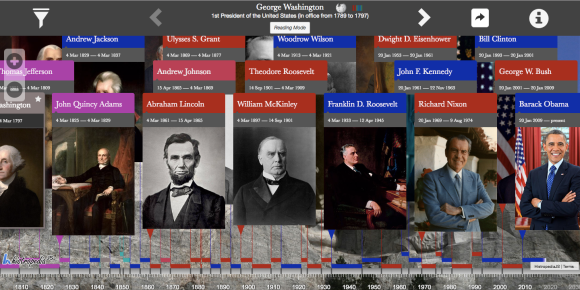
Histropedia is a website that visualises different events in the form of a timeline, usually using a category from Wikipedia or a live query on Wikidata. The website is open for anyone to use, edit, expand or even reuse its source codes.
The website currently has 340,000 timelines listing 1.5 million articles from Wikipedia. You can browse through timelines about ancient and modern empires, battles of World War I, painters of sixteenth century Italy, or merge two different timelines to see who ruled Italy at the time each of those painters lived. You can manually create new timelines or even extract data to be visualized in a tailor-made timeline within seconds using a Wikidata live query.
But what is all this helpful for?
Dr. Martin L. Poulter is a Wikimedian in residence at the University of Oxford. Part of Dr. Poulter’s work is to give introductory workshops to librarians and university staff about Wikipedia and other Wikimedia projects where “a surprising number of librarians haven’t heard of Wikisource, the free library, and a lot of data professionals are unaware of Wikidata.”
I want them to see these projects as communities; as publication platforms; as sources of knowledge that their own databases can interact with, but the most impressive demonstration is when I create a Histropedia timeline. In literally just a few seconds, there’s a colourful interactive view of the Age of Enlightenment, battles of World War I, or any other topic. It’s easy to think of Wikipedia as something that you access and use in a certain way, but Histropedia shocks them out of that.
However, a growing website with sometimes incomplete timelines, can be a double-edged sword in a learning process. The gaps and missing events in Histropedia sometimes encourage teachers to ask Dr. Poulter how to add categories, upload photos or create new pages on Wikipedia.
Navio Evans came up with the idea of Histropedia when confronted by a similar situation. “I was trying to show one of my students how math has evolved over time,” Evans recalls. “I wanted to compare the time periods of the Babylonian and Egyptian civilisations. I was able to find the relevant dates by scanning through the Wikipedia pages, but had to resort to a pen and paper timeline before the student could make any sense of the timescales involved.”
Evans, a native of London, spent most of his career teaching math and science until he came up with the idea of Histropedia, which he co-founded and now works on full time. He is also a Wikidata enthusiast with over 27,000 edits on the website.
Sean McBirnie is Evans’ lifetime friend who worked as an IT support officer until he got hooked by the idea of Histropedia. McBirnie worked mainly on the user experience design of the website and was shortlisted for the UXUK Design Awards.
They worked together on developing the idea for a couple of years until they came up with the “viable approach” they introduced to the public at Wikimania, the annual gathering of the Wikimedia movement which was held in their home city of London in 2014.
“We believe strongly in the power of data visualisation when combined with free knowledge and open data,” says McBirnie. “And our mission is to discover new and interactive ways to explore ‘the sum of all human knowledge’.”

All timelines in the Histropedia directory are automatically extracted using Wikipedia categories. However, anyone can add any missing entries, or correct any mistakes. In addition to the complete timelines in the directory, HistropediaJS is a timeline-rendering JavaScript library that allows custom timelines to be rendered using the core Histropedia engine. For example, on the Presidents of the United States timeline, you can use color-code filter options to show presidents associated with certain political parties. HistropediaJS is available under free licence to be used by any developer for non-commercial purposes.
“Academic audiences are not familiar with the concept of a ‘remix,’ so it’s sometimes hard to get across why the text and images they create should be not just free of charge to the public, but remixable. Histropedia is a great example of what happens when knowledge is freely remixable,” Poulter concludes.
Samir Elsharbaty, Digital Content Intern
Wikimedia Foundation

Can you help us translate this article?
In order for this article to reach as many people as possible we would like your help. Can you translate this article to get the message out?
Start translation